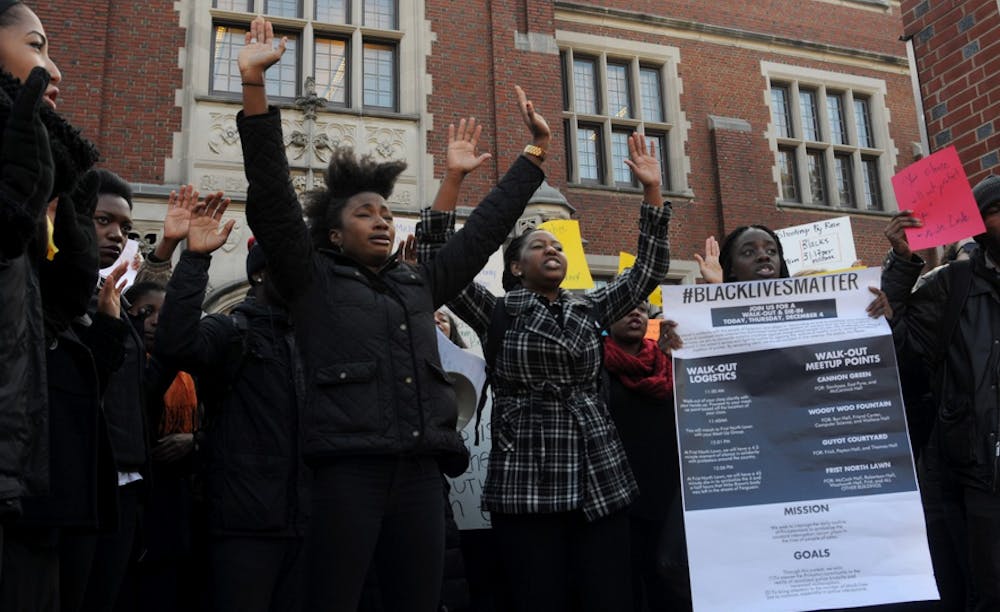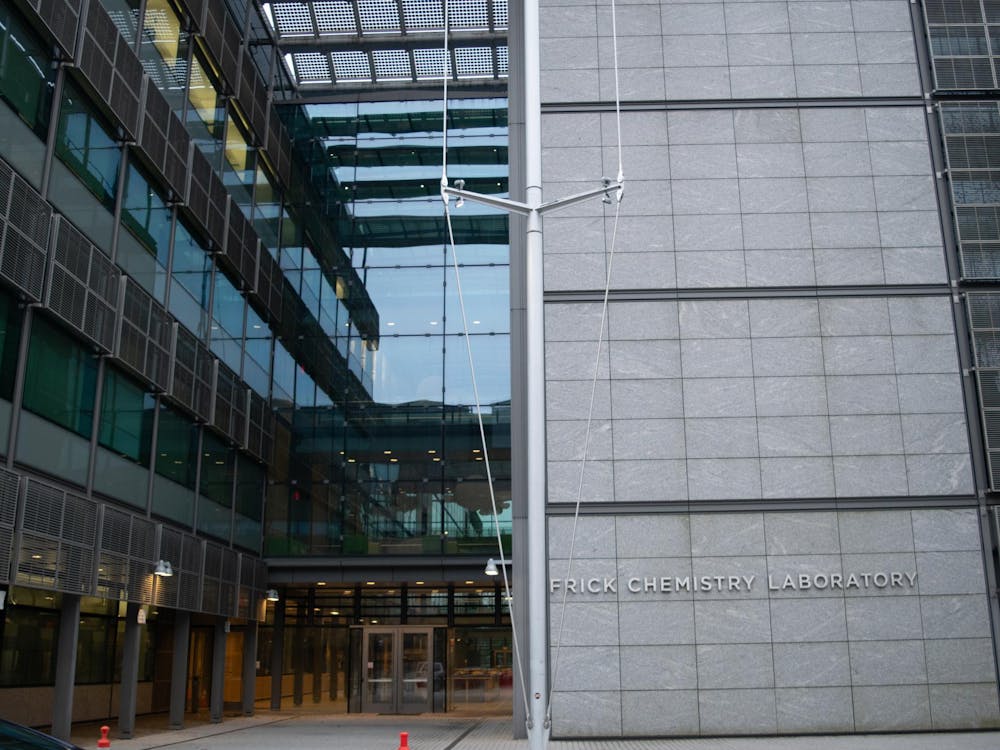Close to 500 students, faculty, administrators and staff participated in a protest on the lawn north of Frist Campus Center at noon Thursday.
“We seek to interrupt the daily routine of Princetonians to symbolize the constant interruption racism plays in the lives of people of color,” protest organizer Khallid Love ’15 announced at the protest.
Love explained that the organizers had been planning the demonstration for several days as a strategic response to recent national events. The protest comes a day after a grand jury declined to indict Daniel Pantaleo, the New York police officer whose chokehold on Eric Garner, an African-American, led to his death. A protest was also held on Nov. 26 to protest the failure of a grand jury to indict Darren Wilson, a Ferguson police officer who shot and killed unarmed African-American teenager Michael Brown.
Protestors gathered in the Frist Wednesday night to write signs in preparation of Thursday’s protest, with many of the signs listing names of African-Americans who had been killed, such as Garner, Brown, Tamir Rice and Trayvon Martin.
The protest started at 11:30 a.m. when participating students silently walked out of their classes with their hands up and congregated in several areas, including McCosh Courtyard, the lawn south of Frist, Scudder Plaza and Cannon Green, before marching to the central location north of Frist. Protestors then stood on the lawn and chanted “Hands up, don’t shoot,” “No justice, no peace,” “Black lives matter” and “We can’t breathe,” the latter chant referring to Garner’s final words before he died.
At 12:01 p.m., the time of Brown’s death, organizers of the event asked all protestors for a moment of silence, which went on for four and a half minutes, to represent the four and a half hours for which Brown’s body was left on the streets of Ferguson, Mo.
Over 200 protestors then staged a “die-in” by lying on the ground for 45 minutes, again to represent these four and a half hours.

Love then read from a prepared statement, which was included in the press release.
“The Princeton call to action stands in solidarity with the people of Ferguson and others demanding an end to radicalized state violence,” Love said. “By remaining silent we are all complicit in this violence. We challenge our campus to stand in the nation’s service and fight for justice by rejecting the culture of apathy and reviving Princeton’s tradition of protest.”Students who attended the demonstration all agreed that this was both a national and a community-wide issue.
“As a Christian, I believe that when you see that there is hurt in the community and people are crying out, you must stand next to them and offer your support and your grace,” Antonio Nunes ’17, who attended the demonstration, said. “Seeing the passion and the grace exhibited by the members of the black community, and the Princeton community, has just really inspired me to be even more active and be more aware of the situation.”
“As a white guy from Florida, I haven’t really been exposed to the kind of prejudice that a lot of the other protestors have experienced, and it wasn’t until I came here that my awareness grew deeper,” he added. “It was important for me to be here and show solidarity, since this issue involves everyone.”

Overall, Love said that he was satisfied with the turnout of the protest.
“I was hoping it would be diverse, and it was. I was hoping it would be substantial, and it was. I was hoping it would be powerful, and it was,” he said.
Deputy Dean of the Office of the Dean of Undergraduate Students Thomas Dunne, who was present at the protest, explained that he was informed of the intention to stage the protest last night and helped the students coordinate several aspects of the demonstration.
“Our office helps them work through logistics and gives them the fullest range of ideas where we can be in support of free speech,” he explained. “The reason we have our staff present at this demonstration is to really show our support for free expression.”
Dunne said that it was the first time during his time at the University that he had ever seen a “die-in” and added that it was really encouraging to see students engaged and involved in national issues.
“This fall, seeing the march on the Street and the protest today — they’ve definitely been the largest crowds that I’ve seen,” Dunne explained. “There’s a lot of activity and engagement here, and I’m happy to see students expressing themselves.”
Love added that while he was not sure if there was another upcoming demonstration in the near future, it was important for the protestors to continue to make members of the campus community aware of the issues currently facing them.
“We all have to be in that crusade for justice and that crusade for a better world,” he explained. “This is a national crisis — it’s larger than Princeton, larger than Ferguson. It’s a quintessentially human problem"








